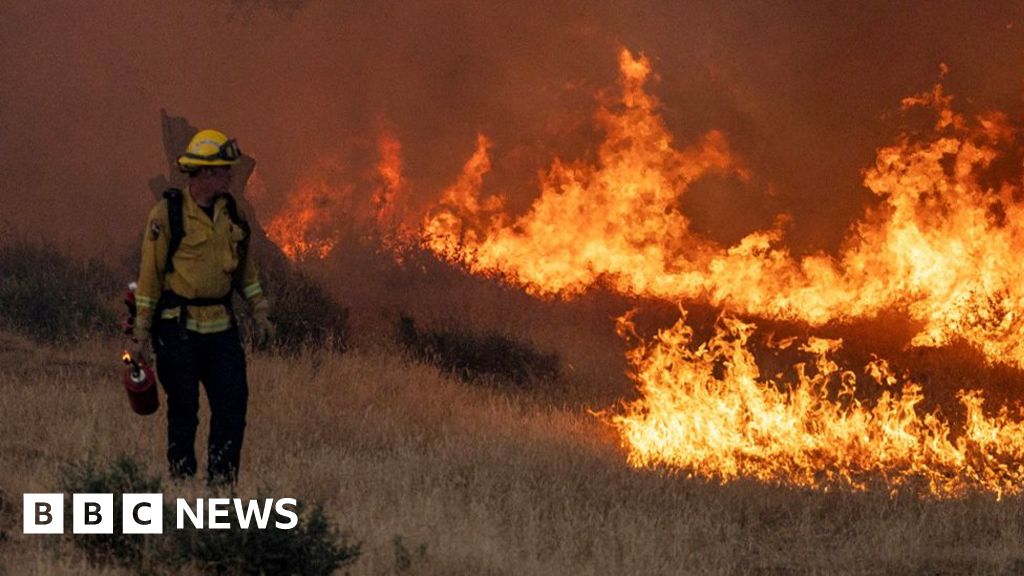- Author, Mallory Moench
- Role, BBC news
-
Thousands of people in Northern California have been told to leave their homes as wildfires in the state increase during a heat wave.
About 28,000 people were under evacuation warnings or orders Thursday after the Thompson fire broke out two days earlier. according to the California Department of Forestry and Fire Protection (CalFire).
The dangerously hot weather is expected to continue, with temperatures reaching 47 degrees Celsius in some areas until early next week.
No one has died, but 74 buildings in the state have been destroyed or damaged by fires this season.
As of Thursday evening, the Thompson fire was 7% contained, marking some progress as a crew of nearly 2,000 battled the flames.
According to CalFire, at least four people were injured, but the severity of their injuries is unknown.
About 240 miles (387 kilometers) south of the Thompson Fire, the French Fire suddenly ignited Thursday evening, forcing evacuations and road closures in Mariposa County.
According to local media, officers went door to door informing residents of the evacuation orders, while patients at a local hospital were asked to stay home.
The French fire continued to spread on Friday. According to the latest update, the fire is 0% under control and more than 800 hectares have burned.
The city of Oroville, near where the Thompson Fire started, canceled its July 4 Independence Day fireworks display due to the risk of another fire.
“The last thing we need is someone who bought fireworks from a local fire stand going out and doing something stupid,” said Butte County Sheriff Kory Honea. “Don’t be an idiot, start a fire and create more problems for us.”
Mr Honea said there had been four fires in the area in recent weeks and warned the danger was far from over.
“This is a bad fire season,” he added.
Fire season has recently begun in California and usually lasts until October. The size and intensity of fires in the state have increased in recent years.
The amount of summer burned areas in Northern and Central California increased fivefold between 1996 and 2021 compared to the previous 24-year period. Scientists attribute this to human-caused climate change.
This week, the National Weather Service issued extreme heat warnings and red flags — indicating hot, dry and windy weather — across the state. The agency said “hazardous” temperatures posed a high to extreme risk of heat stress or illness.
According to CalFire, about two dozen fires have burned more than 10 acres that have ignited across the state since the last week of June. The largest, at nearly 14,000 acres, was in Fresno County.
California Governor Gavin Newsom declared a state of emergency in Butte County to provide relief.
The Thompson Fire started Tuesday in Oroville, about 70 miles north of the state capital of Sacramento. The city is about 20 miles from Paradise, which was devastated by the Camp Fire in 2018, which killed 85 people. Fires have swept through the region in the years since.
CalFire spokesman Robert Foxworthy told the BBC that the fire had stopped growing as the winds eased, but that the heat – expected to reach 110 degrees Fahrenheit (43 degrees Celsius) on Thursday – was the “biggest factor” affecting firefighters.
Two days after the fire broke out, many residents were still unable to return home.
Brittanie Hardie, a Louisiana native who recently moved to California, told the San Francisco Chronicle that she wasn’t home when her friend evacuated their apartment and that she had nothing with her other than the clothes she was wearing.
“I knew the wildfires in California were bad, but I didn’t know it was this bad,” Hardie told the newspaper.
Oroville City Councilman Shawn Webber posted a video on Facebook Wednesday showing smoking mounds forming on both sides of a road, and thanked firefighters for preventing further destruction.
The California state parks system said agencies responding to the fire “also have employees with families displaced by these evacuations who are working tirelessly to assist the Lake Oroville community.”
